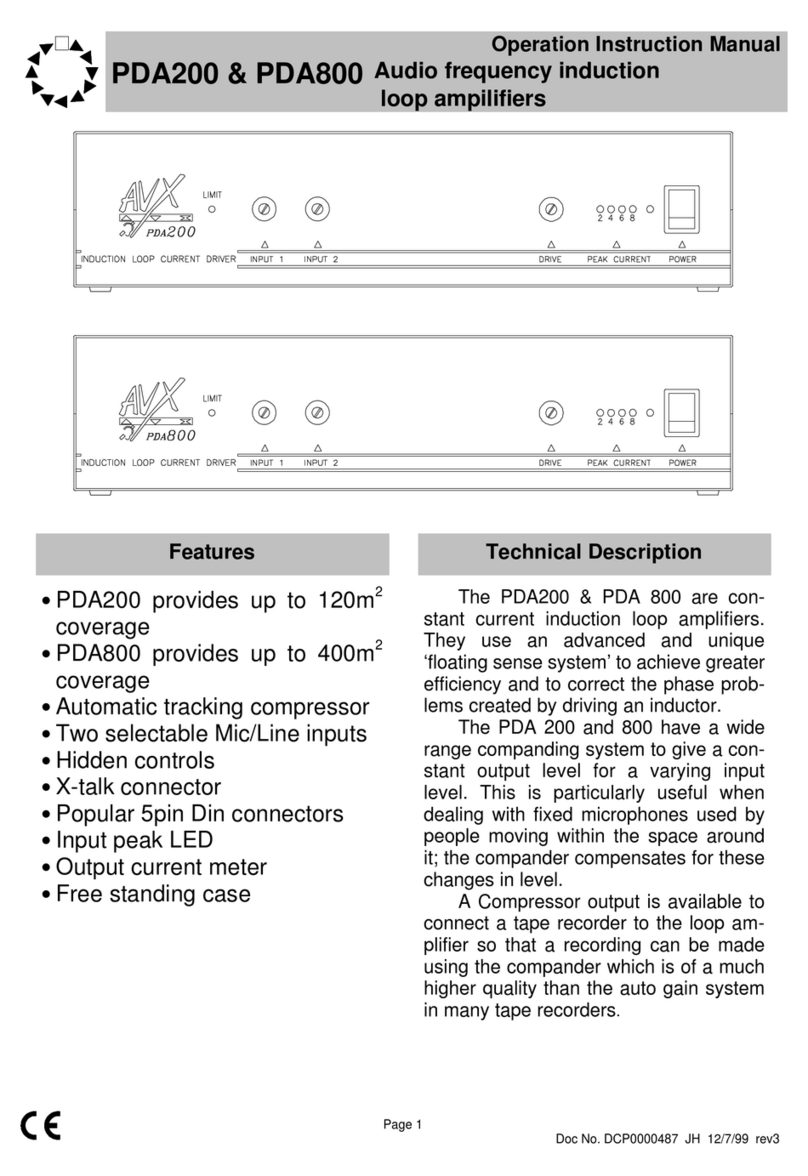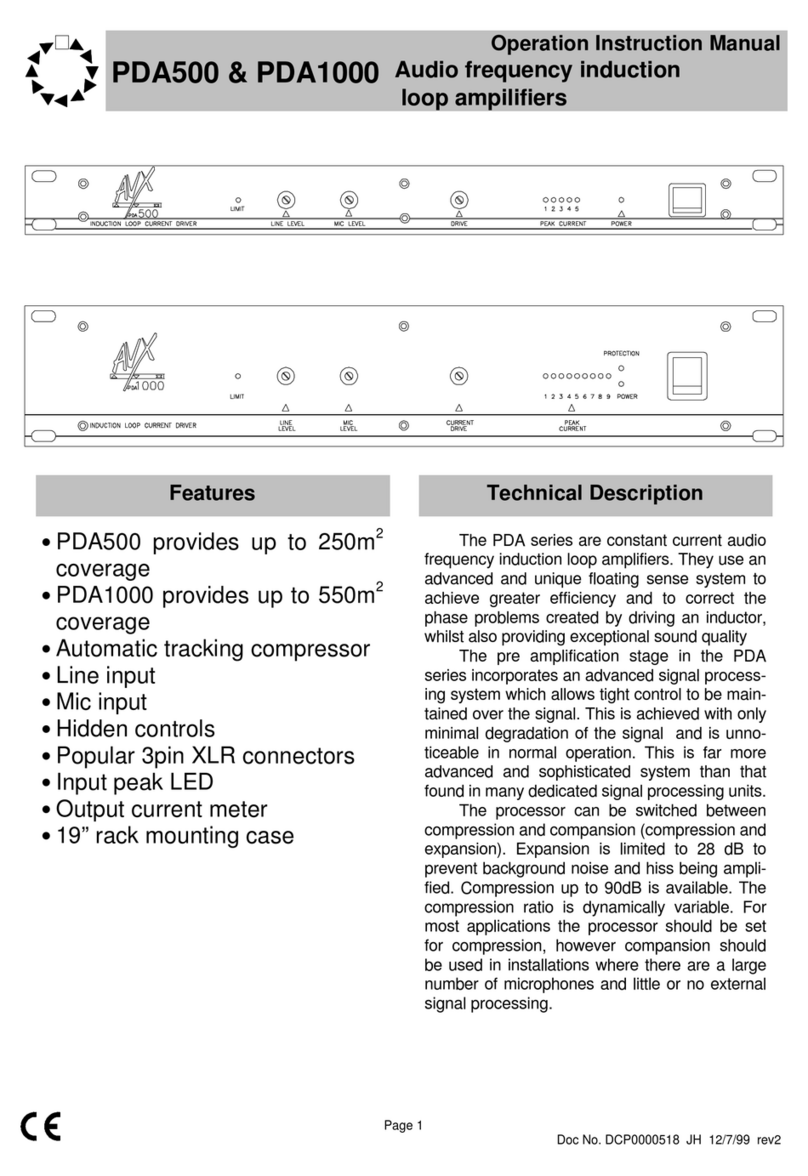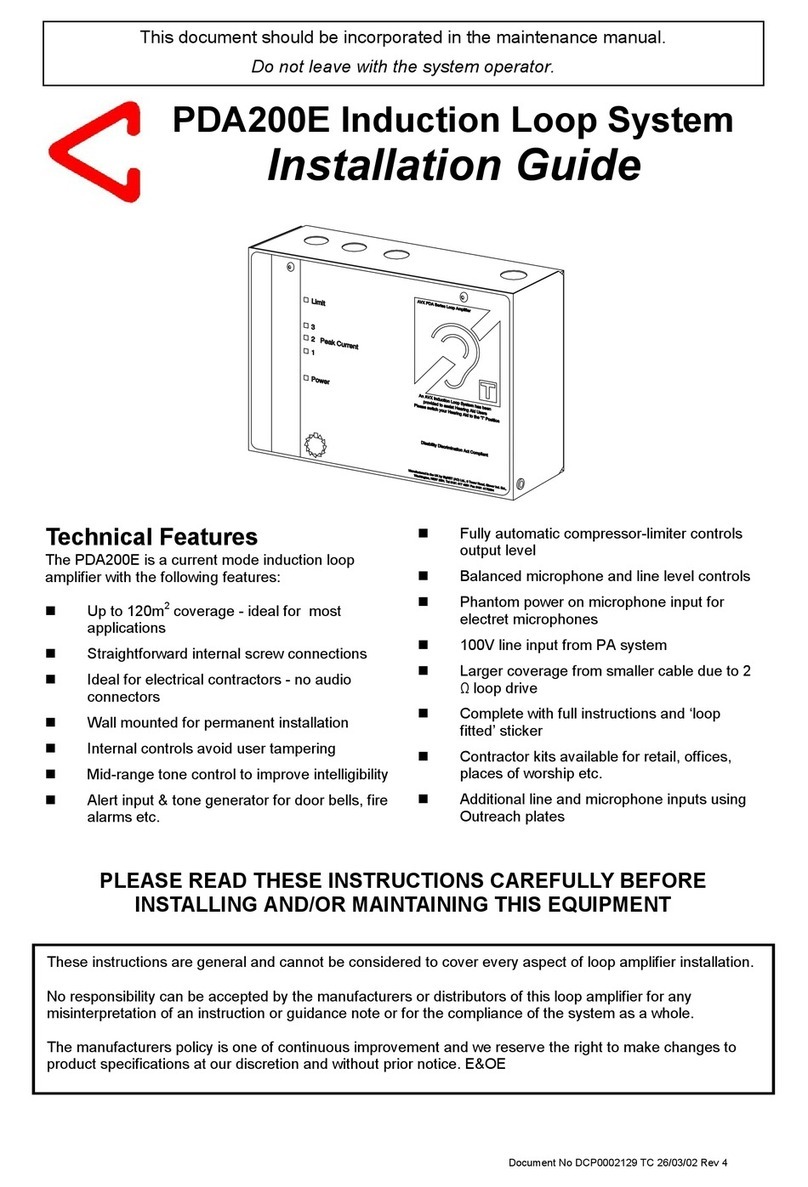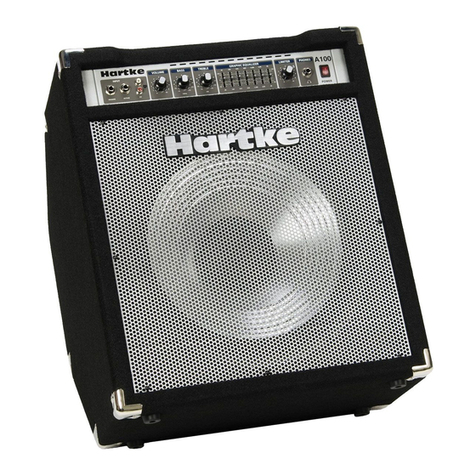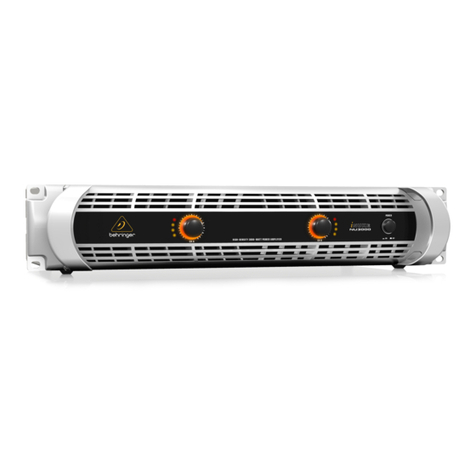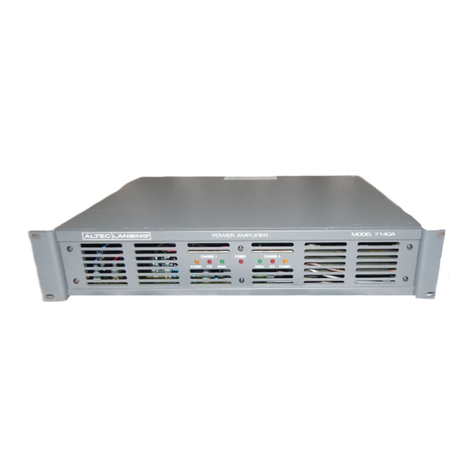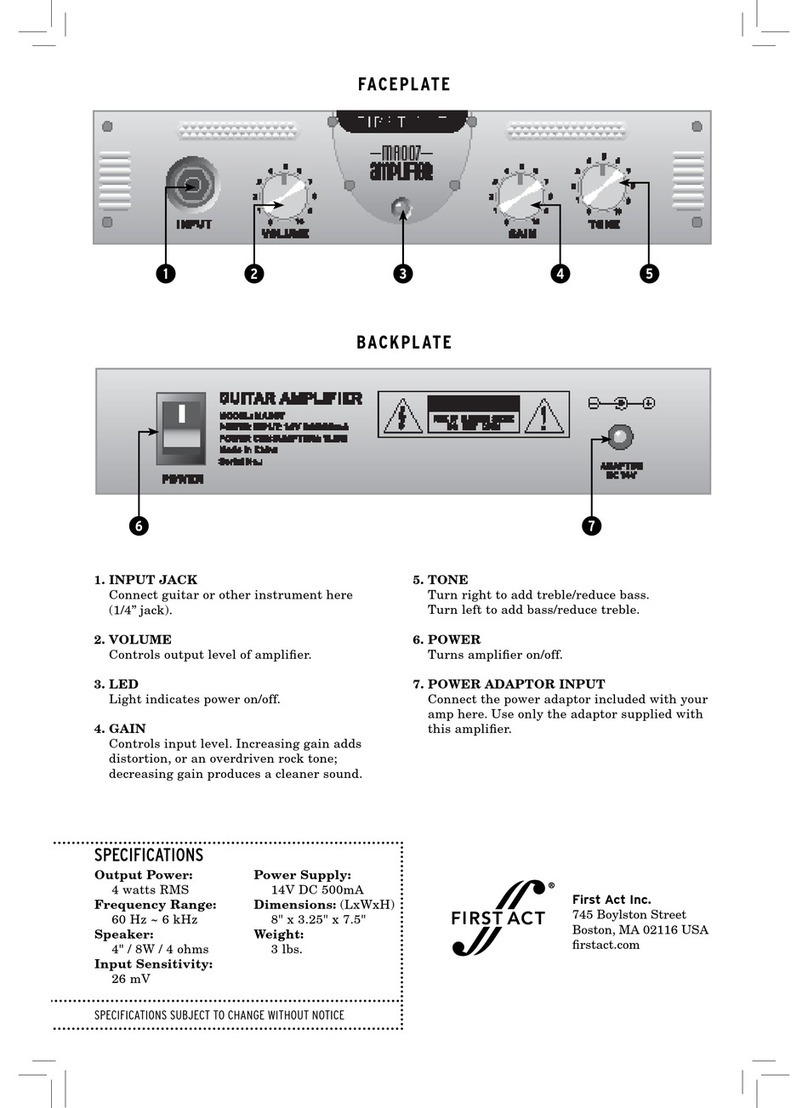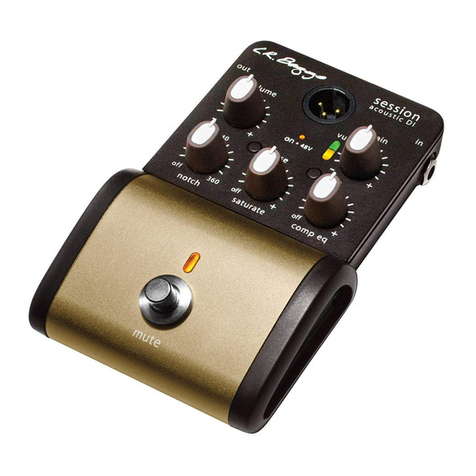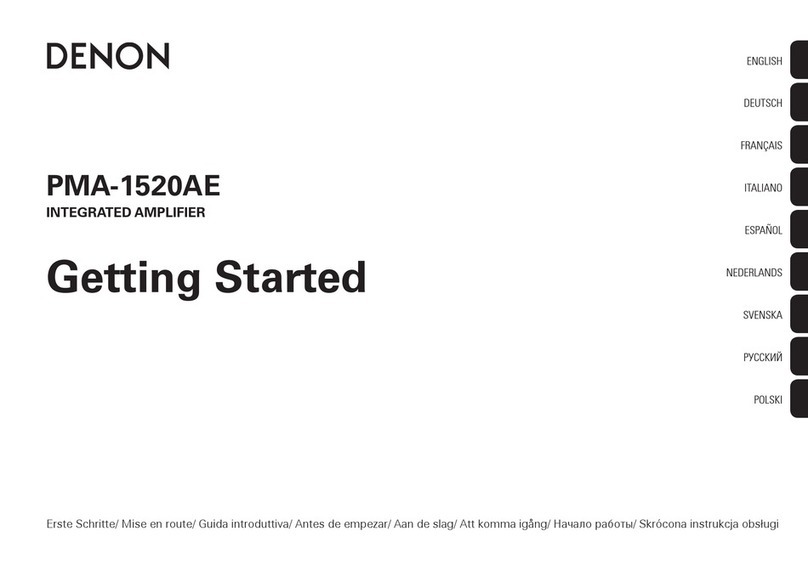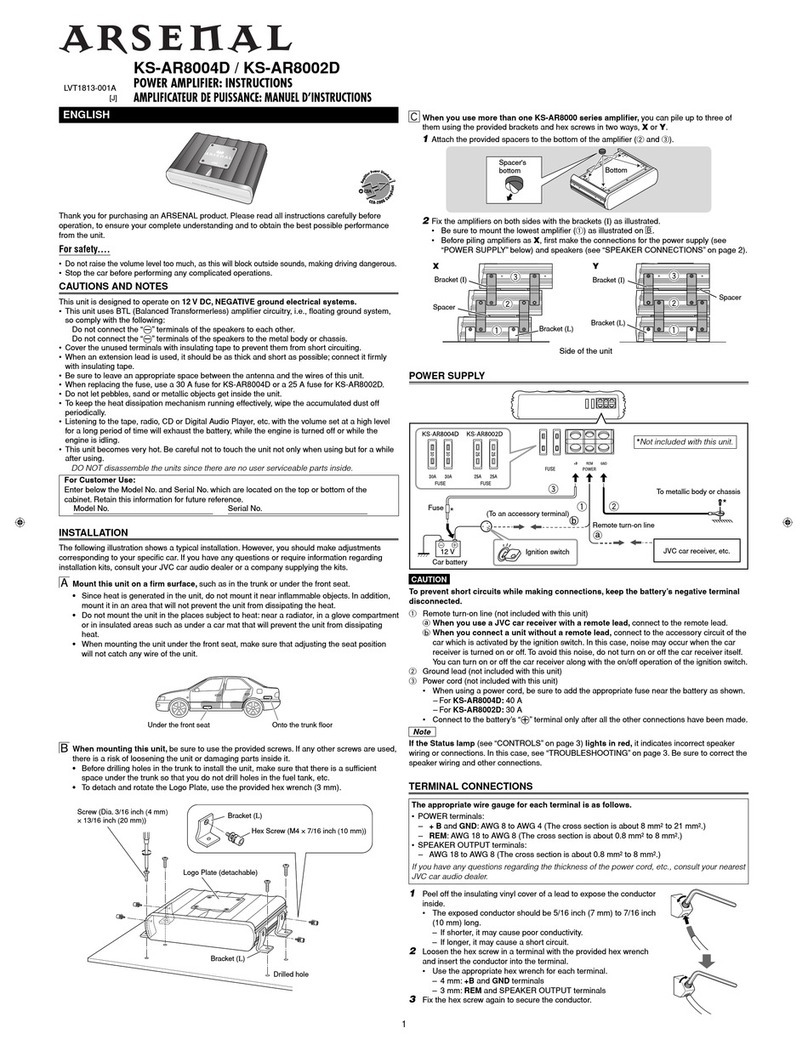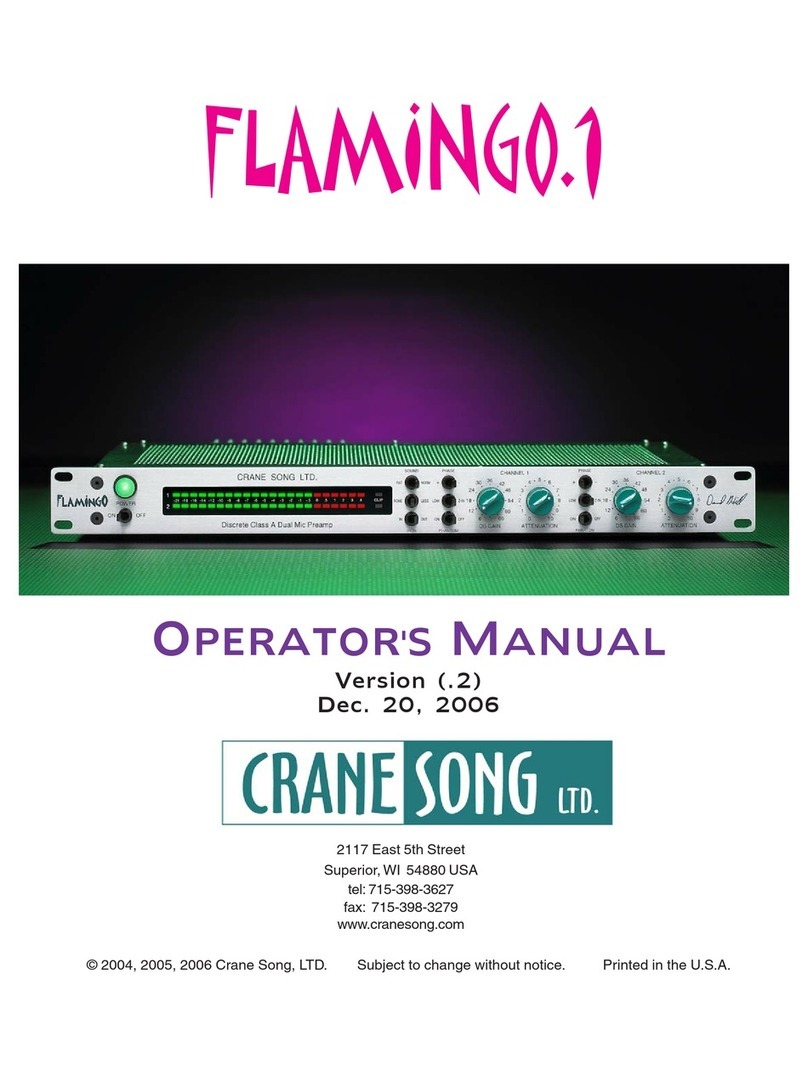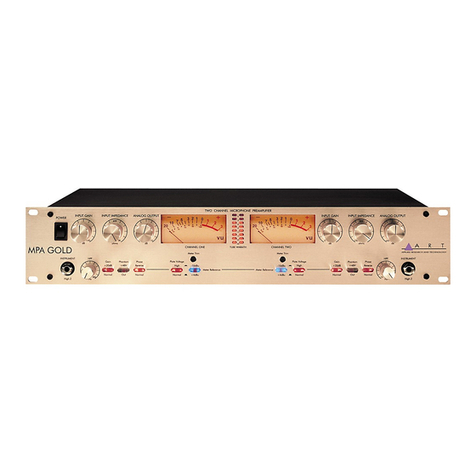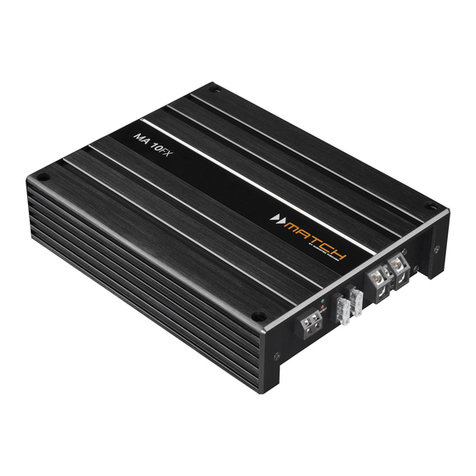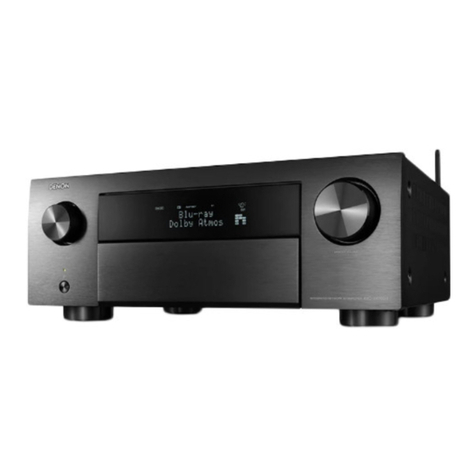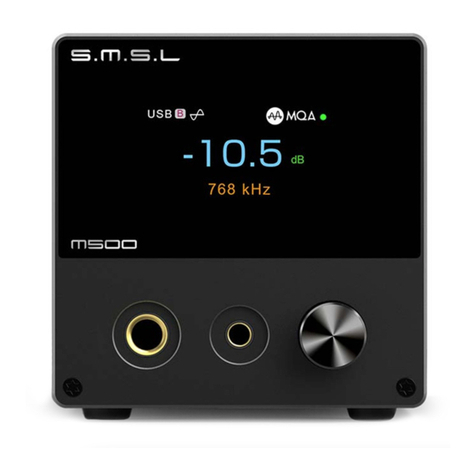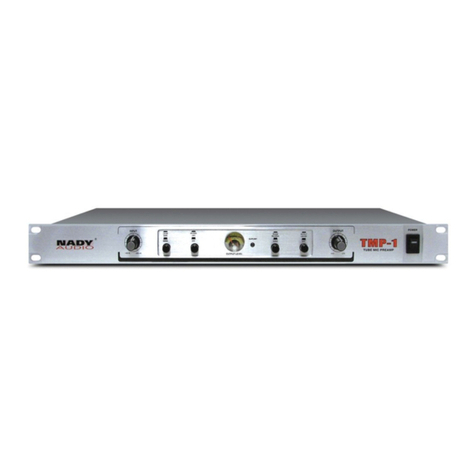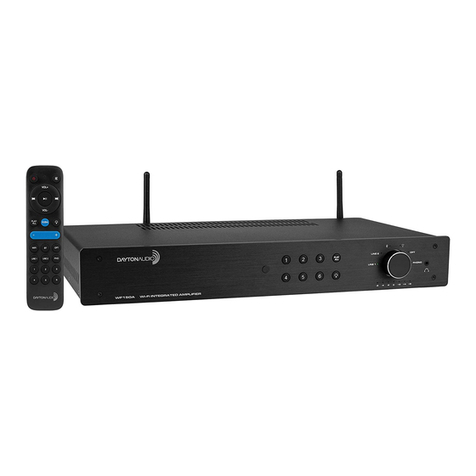Signet Pulse 2.200 LS Administrator Guide

Page 1 of12 DocNo.DCP0001326 DSM 06/01/05 rev7
Features
The P2.200 LSamplifiercontainstwoidentical independent amplifiermodules.Eachhasone Mainand one
Aux.input. Routing logicallowsthe Mainand Aux.to mix;thisallowsthe monitoring tone to pass at all times
and the monitoring systemto operate. Ifthe PTT isoperated, the Main input overridesthe Aux.
Eachmodule’sstatusisdisplayed on the front panelalong with an output levelbargraph and status
indicators. All sectionsofthe amplifierand chargerare constantlymonitored forfaultsorabnormaloperation:
1 The load monitoring checksthe powerabsorbed bythe loudspeakerload at 22 kHzand comparesthis
with the thresholdand windowlevelsset at installation. Ifthe powerdrawndeviatesoutside the windowa
faultisindicated on the front and rearofthe unitand signalled to otherequipment viathe relevant fault
outputs.
2 Ifthe impedancemonitoring tone isnot being received bythe amplifier,both the Load Hiand Load Low
front LEDslight and the rearTone Fail light shows.
3Shouldeitherleg ofthe loudspeakerwiring shortto systemearth thiswill alsolight the Load Hiand Load
LowLEDson the front panel, along with the Earth Fault LED on the rear.
4Mainspowerstatusisalso monitored, along with the internalfuses, to give a complete picture ofthe state
ofthe amplifier.
The load monitoring systemalsoprovidesan output to drivea‘hot swap’automaticamplifierreplacement
system,viathe HSP port, on failureofthe amplifieronly.Shouldaload fail shortoropen circuitbut the
amplifierisstill OK,the hot swap output will not operate. Thismeansthat anyloudspeakers that can be
driven will operate and leavesthe hot swap amplifieravailable foruse on anotherpotentialfailure.
The output fromeachmoduleispresented on athree-waysocket and isfullyfloating. The standardoutput
voltagesare 50Vand 100V, allowing two modulesto be connected in seriesto give 400Wat 100Vline.
The powersupplyhasa 24 Vd.c. batteryinput and an onboard batterycharger.
Technical Description
AmplifierModules
The Aux.and Mainline levelinputsarede-balanced and pass vialevelcontrollers and an analogue switch
into asumming amplifierwheretheyaremixed. Ifthe contactinput isasserted (470 ohmsto ground)alogic
circuit disconnectsthe aux. input.
The protectcircuitdisconnectsthe output transformerwhen the voltage railsfall below22 Volts,exceed 36
Volts,orwhen ad.c.offset ispresent on the output rails.The signalthen passesthrough to the output stage,
which isa feed-forward current-mode bridge circuit and the output levelmetermonitors the levelat thisstage.
The output current ispassed through the primaryofthe output transformerand through alowvalue output-
sensing resistor.The output ofthe transformeristapped at 50 and 100 Volts.Ifthe 50 Volttapsare
connected in seriesthe unit providesa single 400 Watt output at 100 Vline.
PowerSupply
Alarge capacitorreservoirprovidesaverysmooth output, even underlarge current surges.Twoseparate
internal10 Amp fused outputsconnect to the two amplifiermodules.
Aseparate low-current feed passesviathe sleep enableselectorlinkinto the sleep timersection. Another
feed passes,viathe Aux.on LED(thisshowsthat the Aux.powerisavailableon the rearconnector) through
a3Ampfuseto the Aux.powerconnector.With mainsvoltage operation thisunregulated output isat
approximately32 Vd.c.When mainshasfailed, thisoutput isconnected to the batteryand thereforeoperates
at batteryvoltage level.
A27.6 Volt regulatorisalso taken off thisline and used to charge externalbatteriesvia a 20 Amp fuse.
PSUand amplifierfaultsarereturned into the monitoring circuitfromboth amplifiers,slugged to prevent false
faultsbeing reported externally,and passed to the open collectorfaultoutputson the SIPport. Afourth open
collectoroutput isnormallyset asOK(normallyclosed)and openswhen anyfault occurs.
Operation Instruction Manual
Pulse 2.200 LS Dual 200W100V lineAmplifierwithMonitoring

Page 2 of12 DocNo.DCP0001326 DSM 06/01/05 rev7
Block Diagrams Frontpanel indicators
DISPLAY
PSU/
CHARGER
P2.200LSOVERALL
BLOCKDIAGRAM
ISSUE1.
AMP
MODULEA
AMP
MODULEB
AMP
MODULEA
AMP
MODULEB
230VAC
50/60Hz
~
AUX27.6V
OUT
24VSEALED
LEAD-ACIDBATTERY
FAULTS
SHOWSTHEOVERALL CONFIGURATION OFPSUAND AMPMODULES PLUSDISPLAY
SIP
PORT
HOTSWAP PORTB
HOTSWAP PORTA
P2.200LSPSU MODULEBLOCK DIAGRAM
ISSUE 1.
5AMP
HBC
35A
BATTERY
20A
20A
27.6V
REGULATOR
3A
ACIN
44000µF 3A
AMP
MODULEA
AMP
MODULEB
AMP
MODULEA
AMP
MODULEB
16 SECONDS ON
15 MINUTES OFF
SLEEP
ENABLE
AUX
ON
230VAC
50/60Hz
~
AUX 27.6V
OUT
MONITOR
GROUND
OKPSU
FAULT
DISABLE
DC IN
20A
3A
10A
10A
ALL FUSES AUTOMOTIVE BLADE
TYPE, EXCEPT MAINS INLET FUSE
AMPAFAULT
AMPBFAULT
OK, SIP4PSU FAULT, SIP3
AMPBFAULT, SIP2
AMPAFAULT, SIP1
SLEEP
LINE
IN
(AUX)
0dB
LEVEL
P2.200LS AMPLIFIERMODULE BLOCK DIAGRAM.
TWOPER P2.200LS ISSUE 1
LINE
IN
(MAIN)
0dB
LEVEL
MONITOR
ANALOGUE
SWITCH
ANALOGUE
SWITCH
CONTROL 50 V
100V
0V
CONTACT
(PTT IN)
OPEN
CIRCUIT
FAULT
SHORT
CIRCUIT
FAULT
DETECT
FAULT
HSP2
LOAD
HIGH
FAULT
HSP1
LOAD
LOW
FAULT
HSP4
DETECT
Vp
FAULT
HSP3
WINDOW
THRESHOLD
TONE
FAIL
DETECTS CURRENT
THROUGH RESISTOR
EARTH
FAIL
PROTECT
SLEEP IN
-18 -6-30
OUTPUT LEVEL
LOGIC
15V
REG Vpout
+24 Vin
GROUND
+24V IN
OUTPUT
4THORDER BANDPASS
FILTER@22.05KHz
RLA1
RLA
1
OK HSP6
HSP5
IFLOAD LOW&TONE FAILOR PROTECT THEN OK
HSP =HOT SWAP PORT.
CAN AVOIDHOT SWAP IFNATURE OF
FAULT MEANS THERE ISNO POINT
AMPFAULT TO PSU
(OPEN CIRCUITOR
SHORT CIRCUITOR
LOAD HIGH OR LOAD
LOWOR TONE FAILOR
EARTH FAULT)

Page 3 of12 DocNo.DCP0001326 DSM 06/01/05 rev7
Eachamplifier’scurrent statusisdisplayed on the front panel,along with output bargraphsforeachchannel,
and the access status. All indicators are in accordance with BS 5839: Part 4: 1988.
Each amplifiermodule hasa separate indication on the front panelforthe following states:
Name Function / Description
1 Output level A four-element moving dot displayshowsthe current amplifieroutput
levelin logarithmicstepswith 0dBbeing full power.
2 Priority The controlcontact on the main input isclosed.
3 Protect The onboard protection systemshave been activated and the load is
nowisolated.
4 Sleep Thisfacilityisnot used asit doesnot complywith BS5839-8
5 Load Hi The load monitoring systemhasdetected an open circuit orhigher
impedance than wasset at commissioning.
6 Load Low The load monitoring systemhasdetected a closed circuit orlower
impedance than wasset at commissioning.
7 Contact Fault The main input controlcontact orwiring iseitheropen circuit orshort
circuit.
8 Tone fail
(Load Hiand Load Lowlit)
The amplifiercannot detect the 22 kHzmonitoring tone.
The powersupplyunit also hasfront panelstatusindication forthe following states:
Name Function / Description
1 AC in The AC mainssupplyishealthy.
2 DC in The reserve batterysupplyisin use.
3 PSU Fault The batterychargerhasdetected eithera short circuit orhigh
impedance battery.
4 Aux. on The auxiliarypowersupplyforexternalequipment isavailable.
5 OK All the functionsofthe amplifierare normal.

Page 4 of12 DocNo.DCP0001326 DSM 06/01/05 rev7
Name Function/Description Name Function/Description
1 Switch Switchesmainspower
2 AC Input 6AIEC 3 pin connector
(Fuse: 5A250V20mm HBC)
3 Battery
Input
RearofCliffCon 4
PC/P
Pin1- : GND
Pin1+ : +24VDC
@20A
8Hot Swap
Port
4 Aux.
Power
9Output See Output Connections
5 SIPPort See InternalAdjustments(page 9) 10 Level
control Audiolevelcontrolof
closest input.
6 Aux.
audio
input
11 LEDs OC, The maininputcontrolwiring
is open circuit.
SC The maininputcontrolwiring is
short circuit.
E,Earth fault The 100V
loudspeaker line hasashortto
ground.
Hi, LoadHigh. Open circuit
detected,or aimpedancehigher
than commissioned.
TF,ToneFail The monitor tone on
the input signal is not detected.
Lo,LoadLow. Closed circuit
detected or lower impedancethan
commissioned.
12 Window
13 Threshold
7 Main
audio
input
Switch: 470R to GND =on
6k8 to GND =off
See mixmute settingson page 9
14 Level
Used to set-up the fault
monitoring circuitry(see
page 6)
Rearpanel controls&features
13
14

Page 5 of12 DocNo.DCP0001326 DSM 05/01/05 rev7
Installation
Unpacking
Onreceipt ofthe amplifiershipment, pleaseinspectforanydamage incurred intransit. Ifdamage isfound,
pleasenotifyyoursupplierand the transportcompanyimmediately.State date, natureofdamage and
whetheranydamage waspresent on the shipping containerpriorto unpacking. Pleasegivethe waybill
numberofthe shipping order.
Thisequipment isonlysuitableforinstallation inawell ventilated 19 inchequipment rack.Bottomand top
ventilation holesmustnot be blocked and airmustbe allowed to circulate freelythrough the internal
heatsinks.
IfseveralP2.200LSsareinstalled inone rack,at leastone Uofrackspacemustbe leftbetween each
amplifier.
The unit should not be placed in areas;
1with poorventilation
2exposed to direct sunlight
3with high ambient temperature oradjacent to heat generating equipment
4with high humidityordust levels
5susceptible to vibration
Caution To prevent electricshockdo not remove the cover
ACpoweroperation
Due to the sizeand inductanceofthe powertransformer,depending on whereinthe cyclethe poweris
switched on, the inrush current that isdrawn when thisdevice isconnected can be asmuch as150 Amps!
It istherefore essentialthat mainspowerisonlyderived froman automaticsoft start device such asSigNET’s
SOFT4.
Connectthe a.c.powercordto anyone ofthe fourIECamplifierpoweroutletsasdescribed inthe SOFT4
manual.
The unit complieswith BS415.
AC powercord
The wiresin the mainslead supplied with the unit are coloured in accordance with the following code.
Green and Yellow Earth
Blue Neutral
Brown Live
Asthe colours ofthe wiresinthe mainslead ofthisunitmaynot correspond with the coloured markings
identifying the terminalsin yourplug, please connect asfollows.
Wire Plug terminal
Green and Yellow ‘E’ mark
‘EARTH’symbolmark
‘GREEN’mark
‘GREEN AND YELLOW’mark
Blue ‘N’mark
‘BLACK’ mark
‘BLUE’ mark
Brown ‘L’mark
‘RED’mark
‘BROWN’mark
Caution To prevent electricshockdo not remove the cover

Page 6 of12 DocNo.DCP0001326 DSM 05/01/05 rev7
The P2.200LSisdesigned to operate with two 12 Volt VRLAbatteriesconnected in series.
BS5839-81988 requiresthat batteriesmustbe capableofoperating the systemaccording to the project
requirements(normally24 Hours inaquiescent current state plus30 minutesinfull alarm).It alsorequires
that batteriesbe sized so asto provide 25%overcapacityto allowforloss ofcapacityovertime.
It isalsonecessaryto allowforthe current drawn byanyancillaryequipment connected to the Auxiliarypower
output. Auxiliarydevicesshouldbe connected to different P2.200LSamplifiers inorderto spread the load as
evenlyasispractical.
Quiescent Batterycapacity
The current drawn in the quiescent state is75 mAperamplifiermodule, 150 mAtotal.
The current drawn in the quiescent state with all fault indicators lit is150 mApermodule, 300 mAtotal.
Therefore, forworst case, the powerdrawn over24 Hours is7.2 AHr.
AlarmCondition BatteryCapacity
It isdifficult to predict the exact current drawn in alarmcondition so the following approximation isused.
Emergencymessagesconsist ofa tone, silence, message and silence.
The average powercontent ofspeech isapproximately5%.
The average powercontent ofa tone isapproximately20%
The average powercontent ofsilence isnil.
Aconservative estimate ofcurrent drawistherefore 10%ofthe peak.
The peakcurrent drawn fromeach amplifierchannelis11 Amps, 22 Ampstotal.
10%ofthe peakvalue istherefore 2.2 Ampsor, for30 minutes, 1.1 AHr.
However, batteriesmust be de-rated by50%at high discharge ratesand so a figure of2.2 AHristaken
If60 minutesin alarmisrequired, 4.4 AHrwill be required.
Total BatteryCapacity
Add alarmstate batterycapacityto the quiescent capacityand the capacityrequired is9.4 AHr
Add 1/3 to allowfora 25%loss ofcapacityovertime and the smallest batterythat can be used is12.5 AHr.
The smallest standard batteryabove thissize is18 AHrand 27 AHrgiveseven more spare capacity.
Additional batterycapacityforancillaryequipment
Add the capacityrequired foranyancillaryequipment, plusone thirdforbatteryaging. Thesefiguresdo not
change in an alarmcondition.
Worst case quiescent current drawn at 24Vd.c.
SS2N =75 mA=1.84 AHr+1/3 =2.44 AHr
Psiren =50 mA=1.23 AHr+1/3 =1.63 AHr
FCB=50 mA=1.23 AHr+1/3 =1.63AHr
IntegrityMainframe=300 mA=7.35 AHr+1/3 =9.78 AHr
MP2=50 mA=1.23 AHr+1/3 =1.60 AHr
MPP panel(any)=150 mA(all LEDslit)=3.68 AHr+1/3 =4.89 AHr
Batteriesmustbe connected viaasuitablefuse. Werecommend DIN mounted cartridge fuseholders ref
RS371-0340 and 20ARS230-3496 cartridge fuses.
CorrectPower-up Sequence
Plug in mainsconnector
Make sure externalbatteryfuse isout ofcircuit
Connect batteryconnectorto amplifier
Switch on mains
Connect batteryfuse
Power-related fault indicators should extinguish
Ifthe batteriesareconnected beforethe mainssupplyisturned on the inrushcurrent will weaken the internal
batteryfuse.
DC poweroperation and BatteryCalculation

Page 7 of12 DocNo.DCP0001326 DSM 05/01/05 rev7
PTT monitoring
The contact input (PTT in)ismonitored bya resistive potentialdividerasshown below;
6K8
470R
1K
27V6DC
0V
PTTInput
Theterminalvoltageheredefines
thestatusofthePTTline:-
Opencircuit fault
OK
Trigger
Shortcircuit fault
PTTSwitch
The current drawn bythe 6K8Ωresistor(in the
previouslyconnected unit)provesthat the PTT
line isintact. Open and short circuit faultsare
separatelydetected and operation ofthe PTT is
detected bythe change in voltage levelat the
PTT input when the 470Ωisswitched in.
Amplifierand LoudspeakerCircuitMonitoring
Tomonitorthe amplifierand loudspeakersystem,the voltage across the output sensing resistorismeasured
and taken through afourth orderbandpass filter@22.05 kHzto acomparatorwhichdetectsthe powerbeing
drawnat the monitoring tone frequency.The tone isinjected into the amplifiers’input fromthe previous
device in the chain (matrix).
The output fromthe comparatorpassesinto adetectorcircuit, whichcomparesitsvalue with the threshold
set at installation. It alsodetectsthe absenceofthe tone and reportsthisto the tone fail output. The output
fromthe detectorpassesto acomparator,whichdrivesthe load high output. Awindowcontrolbetween that
comparatorand asecond device connected to the load lowoutput isused to adjust howmuch the impedance
can varybefore a fault isflagged.
LoudspeakerCircuits
Anend ofline detection unitissupplied foreachcircuit(twoperdualamplifiermodule).Thesemustbe fitted
at the end ofeachloudspeakerline sothat the line can be monitored inaccordancewith BS5839 part8,
which requiresthat loudspeakerline continuitybe monitored, not the loudspeakers themselves.
LoudspeakerSpurs
Note that thisimpliesthat spurs arenot allowed. Ifaloudspeakeroutput isto be splitto drivetwocircuitsthis
isonlypossibleusing the SPLIT100 Line Splitter,whichprotectseithercircuitagainstashortcircuitinthe
othercircuit. The SPLIT100 isprovided with one EOLdevicesothat one EOLcan be used at the end ofeach
circuit. Ifthe circuitissplitmorethan once, itisnot possibleto detectcircuitfaultsreliablyand sothisisnot
allowed.
Adetectorcircuitconnected to the 50 Voltoutput transformertap monitors the current flowing and any
imbalance must be due to a short to systemearth so an earth fault isdetected.
The load high, load low,earth faultand tone fail outputsarebrought out separately(un-slugged)on the HSP
port.
Faultports
There are three fault output ports; the SIPport, and two Hot Swap ports.
The SIPportisslugged to prevent falsefaultsbeing passed on to the systemand providesfouropen
collectoroutputs;AmpAfail,AmpBfail,and PSUfail (normallyopen)plusOK(normallyclosed).These
normallyconnectto pins1to 4ofthe SIPportviaan internaldualin-line headerwith fourshorting linksfitted.
Thisheadercan be reversed to bring the faultsout on pins5to 8instead. Thisallowsfaultsfromtwodual
ampsto be fed down a piece offlat ribbon cable to an SS2N.
The Hot Swap portsarenot slugged soneed to be gated with the SIPportto prevent falsefaults.Theyare
provided to allowdetailed amplifierfaultinformation thus;Earth Fault, Tone In Fail,Load Low,Load High,
plusan open collectoroutput that onlyconductsifthe faultisnot Load LoworTone Fail to prevent
unnecessaryamplifierswapping.
Acommon faultoutput isalsoprovided whichistriggered byanyorall ofthe sixfaultconditionsalready
described.
FaultMonitoring

Page 8 of12 DocNo.DCP0001326 DSM 05/01/05 rev7
Inputconnections
Connecting the P2.200 to a SigNETiXLS
(prioritisedmixer)including batterybackup.
Important Note: Whenreplacing P2.200
amplifierson siteit must beensuredthat the
iXLS model uses a22Khzmonitoring tone.
Thiswill beshownbyastickeron theunit.
iXLS unitswithout astickermust be
replacedwith22Khzunits. (OlderiXLSunits
use a 20 Khzmonitoring tone).
End of line units (suppliedwith the amplifier)
mustalsobe fitted.
Connecting the P2.200 to a SigNETSS2n(Network station), including batterybackup.
1. SS2n feeding both amplifiermodules
2. SS2n feeding onlyone amplifiermodule
Connecting the P2.200 to anIntegrityMainframe.

Page 9 of12 DocNo.DCP0001326 DSM 05/01/05 rev7
The amplifiermaybe used inconjunction with 100
Voltconstant voltage loudspeakersystems.This
technique isidealinpublicaddress applications
whereitisnecessaryto operate loudspeakers
overadistancefromthe amplifierasitprevents
excessiveline losses.Line matching transformers
must be installed at each loudspeakerto match themto the amplifier. Lowohmspeakers will sound distorted.
Thisissimilarinprincipleto mainselectricitydistribution wherepoweristransformed to high voltagesand
sent long distancesoversmall conductors before being transformed down again at itsdestination(s).
Theseconstant voltage outputsaremostconvenient fordistribution of powerwhen anumberofspeakers are
installed. Eachloudspeakermusthavea100 Voltline transformerwith atap that givesthe powerdesired for
that loudspeaker.The totalnumberofpowersettingsforall speakers shouldbe equalto the amplifierpower
rating orless. See the following diagrams.
100 Volt connection (200 Watt) 100 Volt connection (400 Watt)
Operation and Set-up
Once anamplifieris installedand poweredup,itis necessaryto adjustorverifythefollowing
settings:
1. Ensure that an audio lead froma SigNETrouting matrixisconnected to both Main Inputsa.
2. Checkthat the monitoring tone isnot disabled (the tone fail (TF) indicatorisnot lit).
3. No audio should be routed into the Main input except forthe 22 kHzmonitoring tone
4. Using an oscilloscope (e.g. MaplinPartNo.IN02158)ortrue r.m.svoltmeter(RS218-0265)capableof
reading up to 25 kHz,connectto each100Vline output across 0V+100V.Adjustthe mainlevelcontrol
to give a reading of6 VoltsPeakto peak(2.12 Voltsr.m.s)
NB Default factorysetting is0V(off), otherthan on full Systemdeliveries.
5. Once set,this level controlmustnot beadjustedagain– all level adjustments mustbe carriedout
byaltering the levels from the source equipment (matrix).
Set-up the loadmonitoring circuitis as follows;
6. Turnthe Thresholdand Windowscontrolsto minimum(anticlockwise).Ensureload and End ofline
(EOL)unitareconnected. Ifloudspeakersplitters areused theremustbe an end ofline uniton each
spur. Ifmore than two end ofline unitsare fitted, the monitoring systemwill not operate reliably.
7. Turn up the threshold controlclockwise until the Load Hiand Load lowLED’sare just toggling.
8. Open windowcontrolfully(clockwise).
9. Remove the EOL unit. Load Hishould come, and remain on.
10. Refit EOL, Load HiLED should extinguish.
Note Loudspeakerrunsofmore than 400mare not recommended, asfaultscannot be reliably
detected.
Outputconnections
Output socket

Page 10 of12 DocNo.DCP0001326 DSM 05/01/05 rev7
These adjustmentsshouldonlybecarriedout byqualifiedpersonnel. Thepowerleadand battery
supplymustbe disconnectedbefore the top coveris removed.
The following adjustmentsinvolveremovalofthe top coverofthe unit, removethe side and top screwsthen
lift lid off.
Mix / Mute (one peramp module)
Mix(Default)Used inlifesafetyapplicationsto allowthe high frequencymonitoring tone to pass.When
the Maininput isnot inuse, the Mainand Aux.inputsaremixed together(thisgivesthe
monitortone a path through the amp preventing monitortone faults).
Mute Switch open (pin1 ofmain input)Main input ismuted. Aux. input isaccessed
Switch closed (pin1 ofmain input)Main input isaccessed. Aux. input ismuted
PSU Monitor
Enabled (default)Batterymonitoring enabled.
Disabled Batterymonitoring disabled, thisremovesthe batteryfault fromthe front panelifbatteries
are not fitted.
SleepMode
Disabled (default)Thisfacilityisnot used asit doesnot complywith BS5839-8
All otherjumpers on the unitare all forSigNET’s internal use / testpurposes only.
SIPport
Thesefourfaultoutputspass viaa16-pindualinline socket containing arewireableheaderto the top eight
pinsofthe SIPconnector.
Bydefaulttheseareconnected viawirelinksto pins1to 4thisused bySigNETto designate anode A
amplifier.With the header-reversed pins5to 8areconnected. Thisconfiguration isused bySigNETto
designate a node Bamplifier.
The headercan be rewired to allowanycombination ofthe eight pinsforcustomwiring.
Node A amplifier
(default)(diagram
showsmale
connectoron backof
amplifier)
Node B amplifier
(with header
reversed)(diagram
showsmale
connectoron backof
amplifier)
Internal Adjustments

Page 11 of12 DocNo.DCP0001326 DSM 05/01/05 rev7
Specification
AmplifierPerformance Specification
Sensitivity
Impedance
CMRR
Switch input
Output power
FrequencyResponse
THD
SINAD
Regulation
Output voltage
Operationalmode
Protection
Standbycurrent
Full load current
0dBforboth Main and Aux. Inputs
10Kbalanced (Main and Aux.)
betterthan 60dB
470Ωto GND =on
6k8Ωto GND =off
200WContinuousaverage power
30Hzto 20kHz-3dB+0dB
betterthan 0.1%, 1kHz
betterthan -80dB
betterthan 2dB
100Vline
Current mode, feed forward system
Overvoltage, undervoltage, d.c. offset, short circuit,
thermaland safe operating area
75mA(150mAwith fault lightslit and full load monitoring)
11A
Physical
Material
Colour
Width
Height
Depth
Weight
18swg Zintecsheet steel
Black(RAL 9500 semi-gloss)
430mm
88mm
315mm (behind front panel)
17kg
Powersupply& charger
AC input
DC input
Charging voltage
Charging current
Monitoring
Aux. Supply
SIPPort
230 VAC +/-20%
22 to 34 VDC
27.6 VDC
3A
Short circuit and batteryhigh impedance
1A
Userassignable faultsforthe SigNETnetwork
Monitoring
Detection frequency
Detection type
Window
Sensitivity
End ofLine units, one
required perchannel.
22.05kHz
Windowcomparatorsystem
5%to 20%useradjustable
-40dBto -10dB, useradjustable
0.047μFin serieswith 100ΏRS365-7227
Fuses
MainsInlet
InternalAutomotive Blade
Amp feeds
Battery
Charger
Aux.
5A250V20mm HBC
10Ax2
20Ax1
3Ax1
3Ax1

Page 12 of12 DocNo.DCP0001326 DSM 05/01/05 rev7
PSU pcbshowing internal fuse locations
Fusesare commonlyavailable automotive
blade types
SPECIFICATIONSARESUBJECTTOCHANGEWITHOUTPRIOR NOTICE
SigNET(AC)Limited
6 TowerRoad
GloverEstate,
Washington,
Tyne & Wear, NE37 2SH
Tel:+44 (0)191 417 4551
Fax:+44 (0)191 417 0634
info@signet-ac.com
www.signet-ac.com
Table of contents
Other Signet Amplifier manuals

